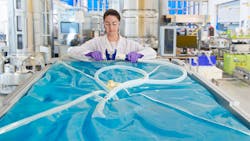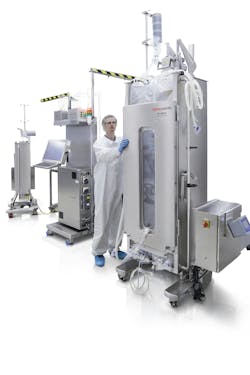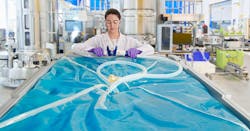Benefits, Drawbacks of Single-Use Technologies In Biopharmaceuticals
The rise of biological drugs is driving explosive growth in the single-use technologies (SUTs) market for bioprocessing. SUTs like plastic bags, bioreactors and connectors offer many benefits over traditional stainless steel equipment — improved efficiency, flexibility, lower costs, reduced contamination risks and faster production times. However, they are not a panacea. Challenges include higher consumable costs, disposal issues, lack of standardization and storage needs.
But companies are betting big that the pros outweigh the cons.
Biologics cannot be chemically synthesized. They must be manufactured within living cells, which makes their production inherently more complex.
They work by targeting specific parts of the immune system to treat conditions such as psoriasis, rheumatoid arthritis and inflammatory bowel conditions, such as Crohn’s disease.
As regulatory approvals for biologics continue to rise, they drive the bioprocessing sector’s demand for SUTs and single-use systems (SUS) to new levels.
According to Acumen Research and Consulting, Maharashtra, India, the market for SUTs will reach $116.3 billion by 2032, up from $26.1 billion in 2022. The company describes the 16.2% compound annual growth rate during this period as remarkable.
Today, SUTs are routinely used in almost every aspect of biomanufacturing processes as media bags and containers, single-use assemblies, single-use bioreactors (SUBs), disposable mixers, vessels, connectors and tubes.
Commanding over 44%, media bags and containers dominate the market, a trend that is expected to continue with the rise of biologics.
Pros and Cons of Single-Use Technologies
The benefits cited for using SUTs versus traditional metal vessels and equipment are legion and well-documented. They include high energy efficiency, low water usage, less floor space required, reduced installation costs, decreased risk of product cross-contamination, faster product development time and faster implementation.
At the same time, however, it would be inaccurate to think of them as a panacea for all bioprocessing situations.
For example, premium pricing of single-use consumables compared to traditional stainless-steel equipment poses financial challenges for some manufacturers and remains a constraint to their widespread adoption. So, manufacturers still need to carefully evaluate the cost-effectiveness of SUTs and SUSs against stainless steel equipment.
High disposal costs remain an issue, too, because there is little recycling infrastructure in place, and even if there was, it takes extensive effort to separate SUTs and SUSs into their homogeneous components.
Another potential issue is that the lack of standardization around the optimal selection of plastic resins for single-use bioprocessing materials may lead to variations in their performance and compatibility.
The requirement for storage space for spare single-use consumables can increase facility costs, particularly for large-scale bioproduction facilities.
Then, there are issues related to the transfer of leachables and extractables during biomanufacturing. The latter are compounds that can be extracted from a container closure system when in the presence of a solvent. Leachables are compounds that leach into the drug product formulation from the container closure system because of direct contact with that formulation. Both, therefore, are studied closely, the first as a baseline to ensure SUS consistency over time and the second to characterize possible adsorption and/or absorption of process fluid.
SUTs Offer Sustainability, Flexibility and Scalability
Ongoing major investments by biomanufacturers illustrate how and why SUTs and SUSs are dominating the market – and how such companies are rising to the challenges they pose.
For example, John Puglia, senior director of research and development in Thermo Fisher Scientific’s bioprocessing business focusing on single-use technologies in Logan, Utah, points out that with the rising number of cell and gene therapies approved by the FDA in 2023 and many more slated for the same this year, biomanufacturers need to make technology decisions that will aid them in flexibility and scalability.
“SUTs offer benefits that can result in shorter set-up times, fewer cleaning requirements and easier customization of reactor size and configuration, which can help with more accurate volume projections,” he says. “SUTs also offer reduced immediate scale and can be easily multiplexed, which can result in the production of large batches while reducing the need for dedicated infrastructure.”
On a more general note, he points out that the ongoing and increasing popularity of SUTs is indeed being driven by commercial manufacturers seizing on the benefits they offer. These, he says, include advantages in sustainability, flexibility and scalability, all helping to reduce cost and environmental impact, improve efficiency and increase production of critical therapeutics.
As such, they are increasingly replacing the stainless steels that biomanufacturing industries originally turned to when they were looking for equipment that was durable, easily sanitized and tolerant of high temperatures.
Puglia points out that such equipment requires users to follow strict sterilization and cleaning processes that can exacerbate water and overall facility energy usage.
“SUTs do not require these same guidelines, which can help manufacturers make strides toward their sustainability goals by saving on water, chemical and energy consumption. SUBs have also been proven to reduce the cost of consumables for manufacturers by 37% when compared to stainless steel bioreactors,” he emphasizes (Figure 1). Thermo Fisher Scientific is also focused on developing new and improved SUTs, and its latest releases include the DynaDrive single-use bioreactor (SUB) and the DynaSpin single-use centrifuge. Centrifuges are under the processing spotlight as they enable closed-system processing of cell therapies during separation and washing processes, minimizing manual operations, reducing contamination risk and decreasing the level of process variability. Puglia notes that DynaSpin improves product yield compared to traditional harvest systems while also enabling operational efficiency, cost savings and sustainable practices in biologics production. “It offers upwards of sixfold reduction in material requirements, eliminating 70% of waste compared to traditional harvest systems,” he adds.Companies including Sartorius, BioProcess International and Alfa Laval have released versions, too.Disposal is an important consideration with SUTs. Customers should work closely with individual customers to find the most sustainable method of their disposal, Puglia says. “All the components within our single-use offerings have pathways to sustainability, and we collaborate with our customers to design specific single-use solutions that meet customer and environmental concerns,” he says. “The materials we use in our single-use systems are known to maintain minimal extractable and leachables materials well below industry standards.”
SUTs Demand Rises
The overall demand for SUTs will likely continue to increase as more manufacturers pivot to more sustainable and efficient solutions and new drugs emerge from clinical trials to the commercialization stage. This means process engineers should familiarize themselves with what is available, Puglia says. He urges them to look for SUTs that improve process efficiency during manufacturing and have scalable tools to maximize their processes at a small scale, knowing that large-volume scalability has been validated.
“Single-use systems also allow for enhanced process monitoring that, coupled with artificial intelligence, can lead to optimal results without making permanent changes to their bioprocessing environments,” Puglia added.
In terms of investment, in January, Thermo Fisher Scientific announced that its Monza facility in Italy had received good manufacturing practice (GMP) certification from the Italian Medicines Agency, which would allow it to manufacture RNA-based products there.
The Monza site specializes in drug product manufacturing in prefilled SU syringes, cartridges and vials. The approval of its GMP facility for RNA synthesis and lipid nanoparticle formulation, plus its co-location with sterile fill and finish, supports an enhanced end-to-end offering for customers engaged in the development of RNA-based therapies and vaccines.
The company also is in the midst of an expansion at its biologics manufacturing plant in St. Louis. When complete, this will include up to four DynaDrive SUBs, each of which can process up to 5,000 liters per batch.
SUTs Provide Controlled Environment
For Greg Verni, senior director, head of single-use and integrated systems franchise for process solutions at MilliporeSigma – the U.S. and Canada life science business of Merck –the case for SUTs and SUSs is obvious.
Verni cites the example of an SUS fill finish operation for a vaccine producer that increased capacity by 40% and reduced campaign fill time from 36 to 12 hours.
“This allowed them to manufacture more batches and meet future demand,” he notes.
Another company that transitioned its formulation and fill-finish process to SUT saw an 85% decrease in labor costs and an almost 19% reduction in the overall process cost compared to stainless-steel equipment. The single-use process also reduced contamination risk and improved sustainability by reducing water-for-injection usage.
“Single-use processes are especially important as manufacturers look to quickly develop different therapies, sometimes with different production platforms and often at smaller scales,” Verni says. “Single-use technologies provide the closed, controlled environment necessary for manufacturing novel therapies such as cell and gene therapies and personalized medicines.”
In his experience, this transition from traditional single-use to closed processing can lead to a 47% reduction in contamination risk, a 55% decrease in gowning time, an 81% reduction in gowning costs, and potential energy and environmental monitoring savings of up to 65% and 88%, respectively.
“While the initial investment for closed process is higher, the long-term cost efficiencies outweigh the upfront costs,” he explains. “This shift represents a future-ready approach, emphasizing the importance of closed, connected and continuous processes in bioprocessing.”
Verni believes that manufacturing will shift from individual components to integrated assemblies and systems designed to operate cohesively. “Moreover, we foresee a growing standardization of single-use assemblies, transitioning from customized solutions to more off-the-shelf solutions comprising multiple components that function together,” he adds.
As biomanufacturers transition to more digitalization, he expects increased demand for process analytical technology solutions to advance automation and control, including MilliporeSigma’s own ProCellics Raman analyzer and MAST autosampling offerings.
“Robust, reliable sampling systems, compatible with single-use, are a ‘must have’ for manufacturing,” he says. “This truly is next-generation sampling on the production floor that integrates chromatographic, spectroscopic and/or mass spectrometric sensors into upstream and downstream unit operations to sample and monitor real-time. Automated aseptic sampling provides clear benefits to the drug manufacturer, including faster results while also freeing up operators to focus on more value-added tasks.”
Merck Takes the Good, Bad of SUTs
Meanwhile, Merck is in the midst of an investment program that includes more than €300 million ($323 million) in a new biologics bioprocessing production center in Daejeon, South Korea, and €440 million ($473 million) to increase membrane manufacturing capacity in Carrigtwohill and to build a new manufacturing facility at Blarney Business Park, both in Cork, Ireland.
The Irish investment, which is the largest ever in a single site for Merck’s life-science business sector, includes a manufacturing facility for the immersion casting of membranes.
Here, after immersion, the cast film separates into two phases: one polymer-rich phase forming the membrane matrix and one solvent-rich phase forming the pores of the membrane. They are used in haemodialysis, membrane-based artificial oxygenation and in drug delivery systems and are typically SUTs.
Merck maintains that such ongoing investment in products and technologies such as SUTs is essential to meet the manufacturing requirements of novel therapies and vaccines.The company also has taken aim at that oft-cited downside of SUTs — leak resistance in films — with the April 24 launch of Ultimus single-use process container film. Designed to provide extreme durability and leak resistance for single-use assemblies used for bioprocessing liquid applications, Merck says the proprietary woven nylon structure provides more than 10 times the abrasion resistance of other similar bioprocessing films. The inert fluid contact layer promotes healthy cell growth and is free of animal-origin components and antioxidants, according to the company. The detailed structure of Ultimus gives an insight into the challenges posed by achieving leak resistance. Its ultra-low-density polyethylene fluid contact layer has a low extractables profile, while the gas barrier layer contains an ethylene vinyl copolymer. A low-density polyethylene outer layer increases the film’s resistance to leak formation. The strength layer, strategically placed between layers of ethylene vinyl acetate, features the woven nylon structure that significantly increases the film’s overall durability, the company says (Figure 2).“Implementing single-use technology can be perceived as challenging due to the risks of extractables and leachables. Ultimus film was created to solve current performance gaps in biomanufacturing films,” explains Verni.The risks are indeed huge. Merck has documented cases of leaks costing biomanufacturers €45,000 ($48,000) and €511,000 ($550,000) each.Overall, Verni points out that the move from stainless steel to SUTs in biopharmaceutical manufacturing continues to be driven by the need for improved flexibility, efficiency and contamination risk mitigation.
About the Author
Seán Ottewell
Editor-at-Large
Seán Crevan Ottewell is Chemical Processing's Editor-at-Large. Seán earned his bachelor's of science degree in biochemistry at the University of Warwick and his master's in radiation biochemistry at the University of London. He served as Science Officer with the UK Department of Environment’s Chernobyl Monitoring Unit’s Food Science Radiation Unit, London. His editorial background includes assistant editor, news editor and then editor of The Chemical Engineer, the Institution of Chemical Engineers’ twice monthly technical journal. Prior to joining Chemical Processing in 2012 he was editor of European Chemical Engineer, European Process Engineer, International Power Engineer, and European Laboratory Scientist, with Setform Limited, London.
He is based in East Mayo, Republic of Ireland, where he and his wife Suzi (a maths, biology and chemistry teacher) host guests from all over the world at their holiday cottage in East Mayo.



